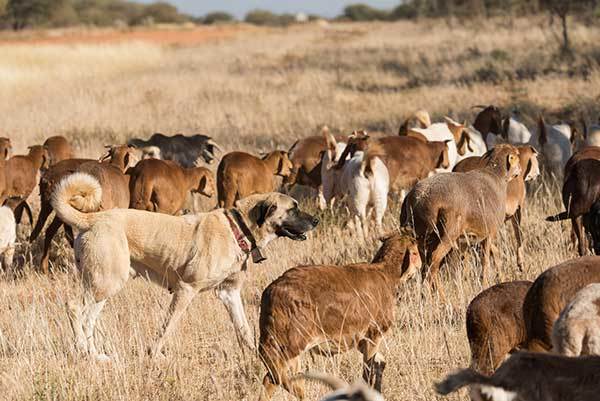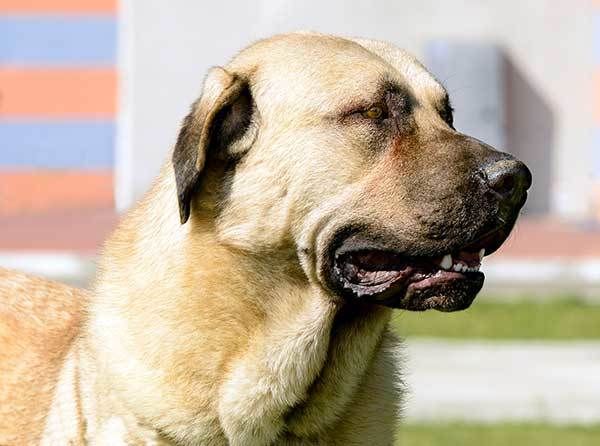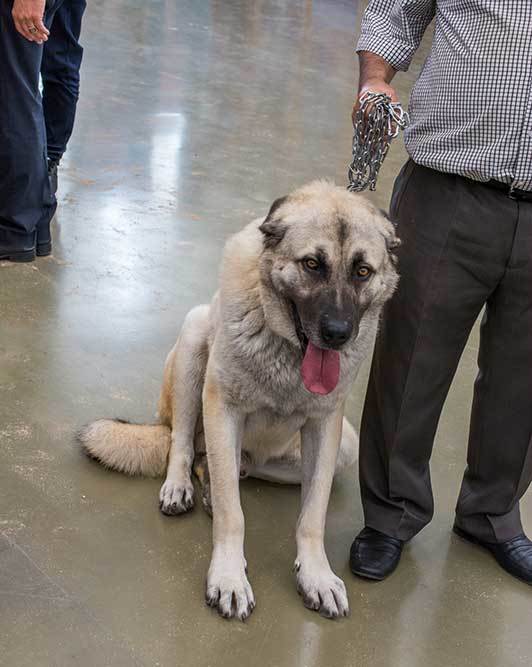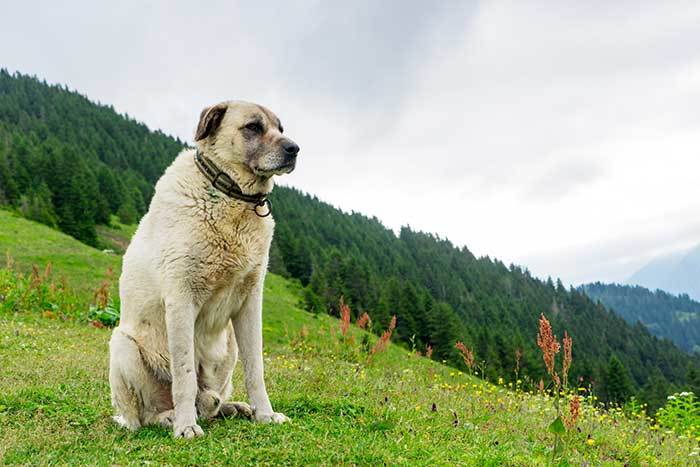When a canine is the national dog of a country (Turkey) and considered a national treasure by its people, it’s definitely worth investigating to find out why.
A large and powerful animal, the Kangal dog is known for his massive size, strength and reputation as a guard dog par excellence.
Kangals once enjoyed life as protectors and guardians of livestock and property.
They are also known as the Turkish Kangal, Kurdish Kangal, Sivas Kangal or Kangal Shepherd Dog and have an intimidating presence due to their impressive size. This made them ideal for protecting humans and animals from fierce predators like bears and wolves.
They are a fascinating type or breed of dog, but it’s important to know their pros and cons if you’re considering adding one to your family.
As with most other dogs, Kangals definitely have the potential to become wonderful family pets.
Read our complete owner’s guide below to view images and to discover some fascinating facts and information about the Kangal breed including its history, temperament and health as well as some general dog care tips.
So let’s dive in and explore the world of Kangals!
Quick Facts About The Kangal Dog
| Country of Origin: | Turkey |
| Breed Group: | Working |
| Other names: | Sivas Kangal, Turkish Kangal |
| Size: | Large-Sized |
| Good guard dog: | Yes |
| Average Weight: | 110 to 140 Pounds |
| Average Height: | 30 to 40 inches |
| Suitable for first time owners: | No |
| Grooming needs: | Moderate |
| Hypoallergenic: | No |
| Shedding: | This dog is a seasonal heavy shedder, twice per year during spring and winter |
| Lifespan: | 5 to 15 Years |
| Suitable for apartment living: | No |
| Coat: | A short, thick double coat |
| Coat colors: | The dog must be a solid tan (i.e. fawn sable, light golden or dun) |
| Trainability: | Difficult |
| Apartment Living: | No |
| Litter size: | 5-10 puppies |
| Hypoallergenic: | No |
| Temperament: | Incredibly loyal, protective, independent, strong-willed, brave, alert |
| Space Requirements: | A large space with a fenced-in yard is preferable (Rural homes are best suited to these dogs) |
| Energy Levels: | Quite high, need at least 40 minutes of meaningful exercise each day |
| Kids friendly: | Yes |
| Price: | Anywhere from $800 to $1300 |
The History of the Kangal Breed
The breed derives its name from Kangal, a small town located in the Sivas Province of Turkey.
Unfortunately, the exact origin of the Kangal dog is unknown. However, there are many rumors and legends that try to explain the origin of this breed.
The first one is that the Kangal was bred from a lion and a tiger during the Babylonian and Assyrian period to offer protection against fierce animals. There were allegedly also used during large battles.
The second one is that the breed was most likely developed from early livestock guardian dogs, which travelled with nomadic people practicing primitive herding methods, from parts of Central Asia to Anatolia starting around 10000 BC to 1300 AC. One of those nomadic clans, the Kayi Clan, took part in the founding of the Ottoman Empire.
It is thought that the current shape of the Kangal Shepherd Dog and other Anatolian Shepherd Dogs goes as far back as the start of the 12th century when the Ottoman Empire was in its formative stages.
The Kangal was commonly used to protect flocks of sheep against fierce predators in tough terrain and under harsh weather conditions in its place of origin i.e. Sivas and Eastern Anatolia.
Today, in different parts of Turkey, where nomadic sheep herding is still being practiced, Turkish Kangal Dogs exhibit the same qualities which were shown by their ancestors.
The Turkish Kangal Dog was introduced to Europe in the 1900s by American couple David and Judith Nelson and it was used as the foundation stock for the present-day Kangal Dog in the United States.
Outside Turkey, the Turkish Kangal Dog’s status as a unique breed is disputed by fans of the Anatolian Shepherd Dog. However, it is widely accepted that the Kangal is actually a separate breed.
Recognition
The Kangal Dog has not yet been recognized by the American Kennel Club (AKC). However, it was registered with the UK Kennel Club in the year 2002 as a member of the Pastoral Group.
Other organizations that recognize the breed today include:
- American Canine Association (ACA)
- Dog Registry of America
- American Canine Registry (ACR)
- Kangal Dog Club of America (KDCA)
- Continental Kennel Club (CKC)

What Does a Kangal Dog Look Like?
The appearance of the Kangal Dog has been genetically refined over the years owing to his continuous use as a protector and guardian dog.
The Kangal Dog has medium sized eyes that may either be oval or almond in shape. The eye color can vary from dark brown to light amber. The eye rims are also pigmented and may either be brown or black.
These dogs have drop ears that hang down, a large head with an incredibly strong jaw, and a tail that curls up over the back.
Kangal Size, Height and Weight:
A full grown Kangal Shepherd is a whole lot of a dog.
In fact, the Kangal Dog is one of the largest dog breeds in the world – right up there with the Irish Wolfhound, Newfoundland and the Leonberger!
As adorable as they are as young puppies, it is important to keep in mind that your puppy will one day be a very large and powerful dog.
The size of a Kangal Dog will vary depending on his gender. Male Kangals reach a height of around 30 to 40 inches and weigh anywhere between 110 and 140 pounds on average. Female Kangals stand 28 to 31 inches tall and weigh around 90 to 120 pounds.

Generally speaking, full grown Kangal Dogs are large, strong and powerful.

Coat:
Kangal Shepherd Dogs also have a short, thick double coat that helps to keep them cozy and warm while working under extreme cold weather conditions. In winter, their coat should be thicker than in the hotter months.
Their hair lies flat and near to the body. It is neither curly nor fluffy.
What Color is a Kangal?
The Kangal Shepherd Dog’s color is a distinguishing feature of the breed; the dog must be a solid tan (i.e. fawn sable, light golden or dun).

Rumor has it that Turkish shepherds were keen on developing tan dogs so they could be easier to spot in the dark and differentiate them from potential predators.
Their face has a black mask covering the entire muzzle and soft, black ears that hang down each side.
Color Variation:
Sometimes the black muzzle reaches the top of the head, and this is mentioned in the breed standard.

Crossbreeds may have white or brindle colorings; white is only accepted when it is below the dog’s knees (i.e. on the feet only) and brindle is a clear sign that the dog is a crossbreed.
ALSO READ: 10 Large Breed Dogs That Don’t Shed
Kangal Dog Behavior and Temperament
Not only do the physical characteristics of the Kangal make him a great protector and guardian dog, it is his natural temperament that makes him a very helpful dog to farmers and families alike. It is a very predictable breed and hence, very dependable.
Although they appear intimidating, Kangals are very gentle dogs that make great family pets. They are great with small kids and adults alike.
They are also very protective in nature, so they always do everything in their power to come to the rescue of their family members. This makes them useful to have at home if intruders are a concern.
They are incredibly loyal when it comes to their owner or family, a trait that starts to be exhibited at around two years of age.
Although they are quite independent and strong-willed, you can consider this to be an advantage considering the fact that they are not prone to separation anxiety like many other dog breeds.
The Kangal does not exhibit any signs of aggression toward their master. Since they were bred in tough Turkish terrain to herd livestock, aggression was not tolerated. Nonetheless, Kangals can be brave, dominant and protective if provoked.
The early Turkish tribes were pleased with the fact that the Kangal Dog was not aggressive to either livestock or people.

However, any dog showing any signs of aggression either toward people or livestock was not used for breeding purposes, so that trait did not become a large part of the Kangal’s temperament.
Kangals usually bark to alert the owner when they sense danger and they are most likely to intimidate and frighten anyone they consider to be a threat to their owner or family.
They will attack predators in order to keep their family and flock safe. If the threat seems to be huge, the dog will normally stand in front of their flock and owner. If the predictor or attacker ignores their presence and barking, the dogs will fight to protect their family and flock.
While they make excellent guardians of people and livestock alike, they might not be ideal for first time dog owners, since their independent nature makes them difficult to train.
As a working dog, the Kangal needs to be kept busy. When they are not working on the farm, they will need a lot of space to play and run around to expend excess energy.
Although they don’t normally require very long walks, you need to keep in mind that their natural habitat has plenty of space for them to run and roam around.
Therefore, it is important to give them a job to do when they are at home alone to prevent behavioral issues. The last thing you want is to come back to a home that has been destroyed by your large canine.
Selective breeding practices have played a major role in shaping temperament and personality traits of the Kangal Dog. That’s why it is important to do thorough research when looking for a Kangal breeder.
Guardian Dog Par Excellence
As we’ve mentioned above, the Kangal is one of the best guardian dogs in the world. These dogs have provided steadfast guardianship for more than 800 years now.
From as far back as the 12th century herding and guarding flocks of sheep in difficult Turkish terrain to the 21st century herding and guarding livestock in remote parts of North America, the Kangal has protection and guardianship in his DNA.
This trait has enabled organizations like the Cheetah Conservation Fund to incorporate Kangal and Anatolian herders in their wildlife conservation efforts.
By using these dogs to guard the flock of sheep in Namibia, the organization has been able to stop farmers and locals from killing cheetahs themselves since they can now rely on these dogs to frighten them away.
Kangals usually work in pairs or as a team to guard their flocks of sheep. This enables two dogs to patrol the area as the other two keep a close eye on the flock. They normally protect their flock by keeping vigil on higher ground.
Their alertness levels are at their highest in the evenings since this is when their early flocks were most vulnerable to attacks.
Once they see a predator, Kangals will first start barking. If their barking is not a sufficient deterrent to predators, they will then roar with great intensity. Kangals will then attack as a last resort, always positioning themselves strategically between the predator and their flock.
ALSO READ: The Shiloh Shepherd – Everything You Need To Know
The Kangal Bite Force
So, how strong are the Kangal Shepherd dogs?
Well, strength is something these dogs are well known for.
In fact, the Kangal bite force is considered to be the strongest of all breeds of dogs. Their bite is estimated at 743 PSI!
With a reputation for the strongest dog bite, it’s no surprise that this has become a hot topic of discussion in the canine world.
Don’t be intimidated though; these dogs were bred to be calm and not aggressive. These dogs will only showcase their immense power when trying to protect their flock and family.
Kangal Dog: Ideal Living Conditions
Working Turkish Kangal Shepherd dogs are calm and happy dogs.
As with all working breeds, however, the Kangal requires a job to do in order to remain happy. These dogs were bred to guard large flocks of sheep from fierce predators such as wolves and bears. That’s exactly what they excel at.
If you don’t have a flock of sheep and/or goats for your new Kangal Dog to guard, be sure to keep them occupied with other activities. Long walks are strongly recommended here.
Kangals also need a lot of space. This means the Kangal is certainly not a good apartment dog. These dogs require a lot of space to roam and play around. If you’re considering owning a Kangal Dog, make sure that you have a spacious and well fenced-in yard.

Having a spacious yard for your Kangal to wander and patrol will play a major role in keeping your pup happy!
ALSO READ: Everything You Need to Know About the Alusky
Training
Training a Kangal Dog is different from teaching any other dog breed. While these dogs are naturally smart, they do not respond well to obedience training or basic commands.
They were purposely bred to care for flocks of sheep and this trait is intrinsic in them. Therefore, your role in training is supervisory rather than that of a dog trainer.
Kangals are not your ordinary guard dogs. They are very hard to train and might not respond well to common training methods since they are often driven by instinct.
This means they are not ideal for inexperienced or first time dog owners. They need a firm alpha. You need to be quite experienced with dogs and training before bringing a Kangal home.
A dog with a huge personality like the Kangal requires a firm hand and lots of positive reinforcements.
Shouting or punishment-based methods will leave you frustrated in no time! With such an independent and intelligent dog, you need to make each training session short and fun. It is best to divide your training into several short sessions instead of holding one long one.
If you’re considering owning a Kangal as a companion dog, you will increase your chances of success by adopting a reward-based positive reinforcement training approach.
Remember that these pups might only obey you when they want to, so patience is a must. Moreover, these dogs should never be left off-leash, unless in a secure, fenced-in yard without other canines, especially those of the same sex.
Kurdish Dog Socialization Requirements
Kangals are used to staying independently out in the fields guarding their flocks.
Companionship is offered to these dogs from an early age by their mother, master and pack. This implies that they will often make their own decisions based on their instinct.
If you are planning to have a Kurdish Dog as a companion in a home with many regular guests, it is best to start socialization training at a young age and continue to do it right through puppyhood.
More importantly, Kangals require early and active socialization to get exposed to other animals, smells and sounds, especially if they are usually used for protection.
Exposing your puppy to their family, property or territory at a young age will help prepare him for his active role.
Exercise Needs
As active working dogs, Kangals definitely need to meet their exercise needs.
To maintain their health, they usually require a fair amount of exercise, but not as much as, let’s say, a Beagle or Border Collie would.
However, these dogs have tons of energy to burn off so prepare to be walking this giant of a dog about 40 minutes per day to ensure he remains healthy and happy.
Being a guardian dog, your Kangal Dog will thrive in a farm or a large outdoor space. In such cases, daily walks may not be necessary since they will usually walk around or engage in activities that allow them to burn off that energy.

Being a very intelligent dog, your Kangal will also require mental stimulation in addition to physical activity.
Basic obedience training and agility classes should generally be avoided. This is because it is virtually impossible for Kangals or any other livestock guardian dogs to successfully complete obedience training.
Giving your Turkish Shepherd Dog time to run, roam and patrol his territory will help him develop into a confident and loyal pup.
ALSO READ: An Informative Guide to the Impressive Gator Pitbull
Grooming Requirements
Due to their short, dense double coats, Kangal Dogs have minimal grooming demands.
Shedding occurs twice per year during spring and winter. His dense coat sheds continuously throughout the year so the Kangal Dog is not hypoallergenic.
At the start of each shedding season, your dog will require thorough brushing with a deshedding tool and metal comb.
The deshedding tool will help you to remove any loose hair from your dog’s undercoat which might otherwise be trapped by his overcoat.
Apart from heavy brushing during the shedding seasons, your dog will require brushing for five minutes every week.
His nails should also trimmed or clipped at least once per month to avoid overgrowth, cracking and splitting.
Unlike smaller dog breeds, these dogs do not require teeth brushing. Instead, dental health can be maintained with a proper diet and periodic visits to your vet.
- 10 Benefits in 1 Daily Treat – PetHonesty’s 10-For-1 Multivitamin chews combine a well-rounded blend of the most essential vitamins and supplements…
- Joint Health with Glucosamine – These natural supplement soft chews have high amounts of glucosamine and other joint support ingredients that reduce…
- Improve Digestion with 1 Billion CFU Probiotics – These one a day dog vitamins contain probiotics and pumpkin, which help keep your dog’s digestive…
Last update on 2024-12-21 / Affiliate links / Images from Amazon Product Advertising API
Feeding Information
As a large breed, the Kangal will require a reasonable amount of food each day. Being a giant dog, your Kangal will certainly eat a lot.
In reality, male Kangals might require as much as 3500 calories per day from their food, so consider this if you are convinced this breed is right for you.
Feeding your dog that much each day can actually add up very quickly. However, Kangals have a slightly lower appetite compared to many other giant dog breeds.
The best food for feeding giant breeds like this is a dry kibble along with wet dog food. Full grown Kangal Dogs will need about 6 to 7 cups of high quality dog food per day in order to meet their daily caloric requirements.
Buying a high quality dry kibble for your dog is strongly recommended since it must be specially made for giant dog breeds.
Another good option for active guardian dogs is a raw food diet for dogs. A raw food diet will consist of organic meats, bones, some eggs, fruits and vegetables.
- One (1) 13 lb bag of ACANA Singles Limited Ingredient Beef and Pumpkin Dry Dog Food
- High protein dog food recipe features 65 percent** high-quality beef ingredients and 35 percent*** wholesome fruit, vegetables and nutrients, and…
- A fiber-rich blend of vegetables, featuring sweet potato and pumpkin, in this grain free* dog food provides digestive support
Last update on 2024-12-27 / Affiliate links / Images from Amazon Product Advertising API
Kangal Life Expectancy
The Kangal Shepherd Dog should live pretty long for a dog of his size.
The average Kangal lifespan is around 12 to 15 years, which is typical of dogs around a quarter of his size.
Of course, to live this long, your dog should get proper diet and nutrition as well as the right amount of exercise to maintain him in a healthy condition.
Potential Health Issues of Kangal Dogs
Since the Kangal breed has not been subjected to a lot of interbreeding practices over the years, these dogs are quite healthy but are prone to a few health problems.
Therefore, there are a few health issues or conditions that you should watch out for when looking to adopt a Kangal Dog. These conditions include:
Hip dysplasia: it is not uncommon for Kangals to experience hip dysplasia so this is one of the conditions to watch out for. Hip dysplasia can be very painful when it comes to arthritis in the hip joints.
Entropion: this health issue is often inherited (i.e. genetic), but it can also be a result of a severe eye irritation. It is characterized by an abnormality of the eyelid whereby the outer lid moves inwards. As a result, the eye hairs keep on rubbing the eye leading to inflammation and severe discomfort.
Hotspots: these often begin as a minor bacterial infection which can spread quickly and cause large patches. Turkish Kangal Shepherd dogs living in warm and wet climates must be checked regularly for any obvious signs of hotspots.
Lipoma: this consists of benign lumps of fat that often develop from the subcutaneous tissues around the abdomen and the chest area. Such lumps are usually not dangerous but can sometimes increase in size and cause discomfort.
- ACTIONABLE HEALTH INSIGHTS: Test for over 270 genetic health conditions and get actionable insights to help you give your pup the best care possible….
- MOST ACCURATE BREED IDENTIFICATION: Test for over 350 dog breeds including dingoes, coyotes, wolves, and village dogs. Using a research-grade…
- TRAIT INSIGHTS THAT HELP YOU BE MORE PREPARED: Test for 55 physical traits. Size, coat, grooming needs — your dog’s traits don’t just make them…
Last update on 2025-01-13 / Affiliate links / Images from Amazon Product Advertising API
So, how do you find healthy Kangal Shepherd puppies for sale? Let’s find out below:
Finding Healthy Kangal Puppies for Sale
Are you convinced that the Kangal Dog is a good match for you and that you have the time and resources to take proper care of your pup?
Great! The next step is to find reputable Kangal breeders near you. Go online and do thorough research on breeders.
A good place to get started is the Kangal Dog Club of America. It is also a good idea to ask your veterinarian about Kangal Shepherd puppies and reputable breeders in your area.
What to Look for in a Reputable Kangal Breeder
Your new Kangal Dog will be a member of your family for many years. Therefore, there are a few things you need to keep in mind before making this commitment.
Firstly, you want to be certain that the dog you’re getting is a good match for you and your lifestyle.
Secondly, you need to ensure you are adding a healthy and well-mannered dog to your family.
A reputable breeder should be frank and answer any questions that you might have in mind about their Kangal Dog for sale. They should also ask you a number of questions to ensure you have what it takes to take proper care of this dog.
Ask to view the health certifications for your puppy’s parents. Ideally, you should also visit their premises several times before buying a Kangal puppy from them. That way, you can rest assured that the puppies and dogs are kept in a clean, comfortable and friendly environment.
Also, ask to see at least one of your puppy’s parents in their premises so that you can get a good idea of their personality and how your Kangal puppy is most likely going to turn out.
Most importantly, get a DNA test done. These days, DNA testing for dogs is extremely important. It gives you information about the dog’s lineage as well as details on any health issues so you can take home a healthy puppy.
Look for a reliable home DNA testing kit and follow all the instructions carefully. For the most accurate results, we recommend the Embark Dog DNA Test Kit as it offers the largest database in the market.
How Much Does a Kangal Puppy Cost?
If you are considering buying a Kangal puppy, prepare to pay around $1,000 to $2,000 USD for one.
Usually, the price depends on availability, location, health of the puppies and the breeder under consideration.
Also, you should factor in the cost of food and vet bills, among other costs of owning a dog.
ALSO READ: Your Complete Guide to the Euro Mountain Sheparnese
Kangals Dogs for Adoption
Sadly, some dog owners do not do enough research before getting a dog.
The Kangal Dog is a breed that was developed for a specific purpose. These are giant dogs who are very independent in nature. That’s why some of these dogs end up in shelters or rescues. Such dogs need to be re-homed to much more appropriate homes and dog owners.
Save yourself the hassle of housetraining and the stress of home destruction by going through a rescue.
Inquire at your nearest animal shelter or rescue organization for Kangal Dogs for adoption.
You may also want to contact local Kangal Rescue Breed Clubs to see if they have any recommendations for Kangal Dogs in need of a forever home.
Kangal Dog: Conclusion
The Kangal Dog is a true gentle giant.
Considering the fact that Kangals can weigh as much as a grown-up human being, it is nothing short of extraordinary that we can keep them as companion dogs in homes with young children.
These dogs are fantastic with small kids and get along well with other family members as well. They will generally tolerate rough play from their family’s children while being fiercely protective of them.
While Kangal Dogs are not ideal for houses in urban areas or homes with a limited amount of outdoor space, they have the potential to be great family dogs for those that have enough space and time to meet their exercise needs – both mentally and physically.
The Kangal definitely has lots to offer: fearless guardianship, unwavering loyalty, and unconditional love. As long as all of their needs are met, this cute dog is sure to make a loyal companion for a long time to come.
Checkout Our Favorite Dog Products
1. BEST PUPPY TOY
We Like: Snuggle Behavior Toy with Heart Beat & Heat Pack – Ideal toy for new puppies.
2. BEST DOG TRAINING PROGRAM
We Like: Doggy Dan The Online Dog Trainer – Stop any dog problem and raise the perfect puppy with The Online Dog Trainer.
3. BEST FOOD FOR DOGS AND PUPPIES
We Like: Victor Super Premium Pet Food – Ideal for growing puppies and pregnant or lactating females. Also provides sustained energy for sporting dogs and dogs with high physical demands.
4. BEST DOG DNA TEST
We Like: Embark Dog DNA Test – Embark screens for over 250 dog breeds + tests for 170+ genetic diseases including MDR1 drug sensitivity, glaucoma, degenerative myelopathy, and dilated cardiomyopathy, some of the most common adult-onset diseases in dogs.
5. BEST DOG PUZZLE TOY
We Like: Outward Hound Interactive Puzzle Toy – Every dog loves chasing squirrels at the park. The Outward Hound Hide-a-Squirrel Puzzle Toy gives your dog the same feeling as though he was outdoors chasing live squirrels.
6. Best Vacuum to Tackle Pet Hair
We Like: ORFELD Cordless Vacuum – Engineered for homes with pets. With features and tools that dig out dirt, hair and allergens everywhere your pet gets.






